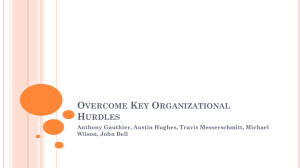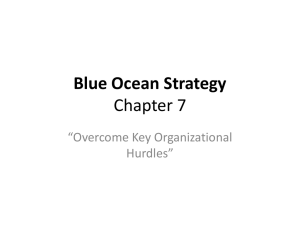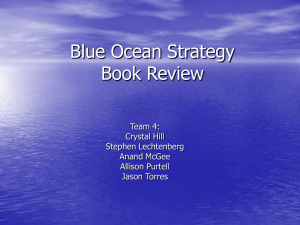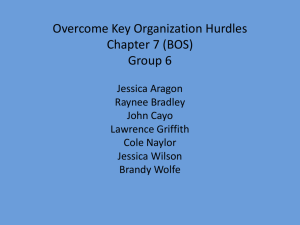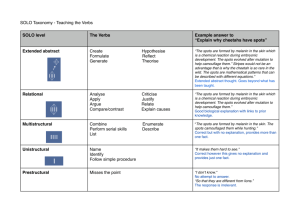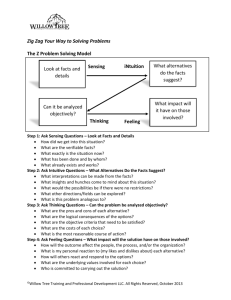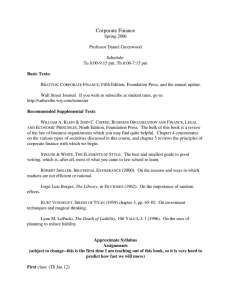Blue Ocean Strategy Ch. 7
advertisement
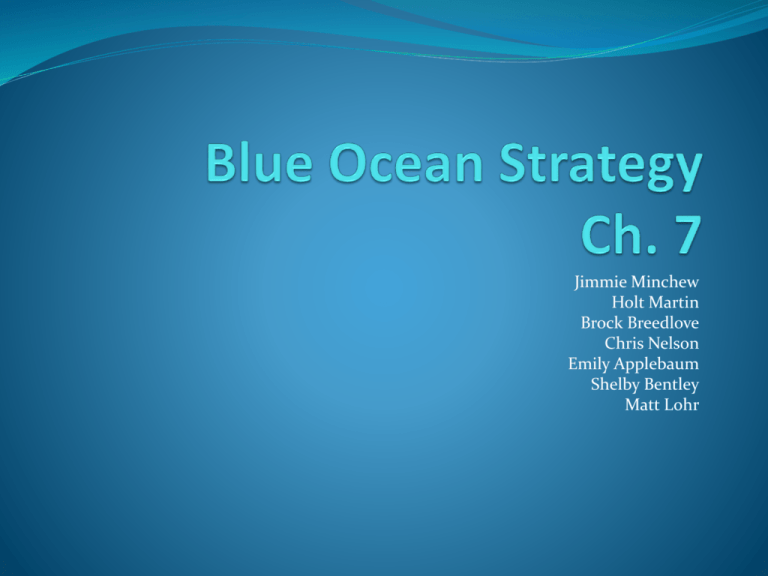
Jimmie Minchew Holt Martin Brock Breedlove Chris Nelson Emily Applebaum Shelby Bentley Matt Lohr Organizational Hurdles Cognitive Limited Resources Motivation Politics Tipping Point Leadership in Action NYPD Bill Bratton “We would have marched to hell and back for that guy.”Anonymous Patrolman The Pivotal Lever: Disproportionate Influence Factors Don’t meet hurdles with equal energy, work around the problem Unlock an epidemic movement Key is concentration, not diffusion Questions to ask to identify disproportionate influence: How to get most bang for buck? How to motivate key players to start an epidemic movement? How to knock down political roadblocks? Home Depot and the Pivotal Lever Tim Crow’s New concentration Create sense of ownership among HD’s 330,000 associates Attain product knowledge customers desire Implement rewards and recognition programs to boost employee morale “Success Sharing Plan” Break Through the Cognitive Hurdle • Direct experience is more effective at motivating than numbers • Make people see and experience harsh reality first hand. • Internally driven change allows quicker and more thorough response Home Depot and the Cognitive Hurdle “Homer Badges Program”- recognizes associates who “live Home Depot’s values” “Aprons on the Floor Program”- aimed at getting more employees onto the floors of its stores Ride the “Electric Sewer” One way to tip the cognitive hurdle Managers need to come face to face with poor performance Show worst reality to superiors to help them realize the need for change Undercover Boss Meet with Disgruntled Customers Observing the market firsthand Don’t rely on market surveys Boston’s Police District 4 Making a difference Numbers VS Reality Home Depot Jump the Resource Hurdle Reality of Limited Resources Trim Ambitions, Discourage Workforce Same mistakes Fight for More Resources Ineffective Multiplying the Value of Current Resources Successful strategy 3 Factors to Leveraging Resources Hot Spots Cold Spots Horse Trading Redistribute resources to hot spots Increase excess resources to areas where resources are insufficient Bratton’ Idea: Increments in performance achieved through increments in resources – the same logic many companies already use Differentiated by identifying the stations receiving most crimes (hot spots) Crime rate decreased while the police force remained the same size Redirect resources from your cold spots Free up resources in cold spots and allocate in a more efficient matter Ex: In 2007 the company sold several underperforming subsidiaries under the name “HD Supply” for $8.3 billion. Helped to reestablish retail operations, management style and customer service Engage in Horse Trading In addition to refocusing, engage in horse trading – trading resources you don’t need for those you do need Home Depot acquired 75% interest in “Aikenhead's Home Improvement Warehouse” in Canada in 1994 – bought the remaining 25% in 1998 Established The Home Depot name internationally Jump the Resource Hurdle How do you execute a strategic shift with limited resources? Multiply the value of resources using: 1. Hot Spots- activities that have low resource input but high potential performance 2. Cold Spots- activities that have high resource input but low performance impact 3. Horse Trading- trading your unit’s excess resources in one area for another unit’s excess resources to fill remaining resource gaps. How New York Transit Police redistributed resources to hot spots Police argued that to increase safety on the city’s subway there needed to be an officer riding on every subway line. This would increase costs greatly and was also impossible given the current budget. Solution was to target “hot spots” because the majority of crime offered at only a few stations and on a few lines. Jump the Motivational Hurdle • For a new strategy to become a movement, people must not only recognize what needs to be done, but they must also act on that insight in a sustained and meaningful way. 3 factors to motivate employees: 1. Kingpins 2.Fishbowl Management 3.Atomization Fair Process Fair Process- engaging all the affected people in the process, explaining to them the basis of decisions and setting clear expectations of what that means to employees’ performance. Signals to employees that there is a level playing field Atomize: Get the Organization to Change Itself Change NYC “block by block, precinct by precinct, borough by borough.” Knock Over the Political Hurdle Angels, Devils, and a Consigliere Leverage Angels Silence Devils Get Consigliere in Top Management Secure a Consigliere on Your Top Management Team A top management team must have more than functional skills such as marketing, operations, and finance. Tipping point leaders engage a consigliere NYPD: Bratton appointed Timoney as #2 Leverage Your Angels & Silence Your Devils Who are my devils? Who will fight me? Who will lose the most by the future blue ocean strategy? Who are my angels? Who will naturally align with me? Who will gain the most by the strategic shift? Discourage the “war” before it has a chance to start Angels & Devils in NYPD Bratton’s policing strategies faced opposition from New York City’s courts. He pointed out the upside and the possibility of lower future crime rates. Bratton teamed with the mayor and the city’s leading newspaper to isolate the courts. Not only did the court system give in to Bratton’s strategy, but it also worked and crime rates decreased. Leverage Your Angels & Silence Your Devils Key to winning over your devils is knowing all their likely angles of attack and building up counterarguments backed by irrefutable facts. Bratton’s readiness to combat crime data issues Questions a leader should ask himself Do I have a consigliere in my top management team or just a CFO? Do I know who will fight me and who will align with my new strategy? Have I built coalitions with natural allies? Does my consigliere remove the biggest land mines so I don’t have to focus on changing those who can’t or won’t change? Challenging Conventional Wisdom Challenging Conventional Wisdom To overcome key organizational hurdles to make blue ocean strategy happen in action, companies must abandon perceived wisdom on effecting change. Don’t follow conventional wisdom Focus on acts of disproportionate influence—it aligns employees’ actions with the new strategy. Conclusion The Four Organizational Hurdles: Cognitive, limited resources, motivation, politics. The Pivotal Lever: Disproportionate influence factors Breaking through the cognitive hurdle—direct experience is more effective at motivating than numbers Riding the “electric sewer” is the first way to top the cognitive rule Meet with disgruntled customers Redirect resources from your cold spots—free up resources in cold spots to allocate in a more efficient manner Three factors to motivate employees: Kingpins, Fishbowl Management, Atomization Leverage Your Angels & Silence Your Devils Don’t follow conventional wisdom
